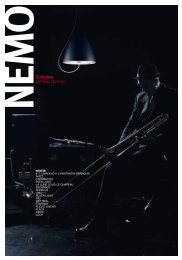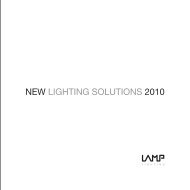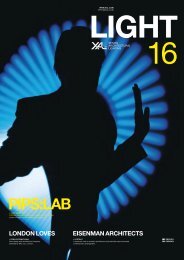WWW.XAL.COM office@xal.com XENON ARCHITECTURAL ...
WWW.XAL.COM office@xal.com XENON ARCHITECTURAL ...
WWW.XAL.COM office@xal.com XENON ARCHITECTURAL ...
You also want an ePaper? Increase the reach of your titles
YUMPU automatically turns print PDFs into web optimized ePapers that Google loves.
D „Ich bin wirklich erleichtert, dass sich mit<br />
Hilfe der modernen Quantenphysik das Universum<br />
endlich erklären lässt“, schrieb Woody<br />
Allen in seinem kürzlich erschienenen Text- und<br />
Essayband Pure Anarchie, „denn ich dachte<br />
schon, das Problem läge bei mir“. Vor allem die<br />
Lichtgeschwindigkeit hat es dem New Yorker<br />
Stadtneurotiker besonders angetan, deren<br />
praktische Meriten ihm plötzlich während der<br />
berüchtigten New Yorker Rushhour beim Versuch,<br />
ein Taxi zu kapern, so richtig klar wurden:<br />
„Beachten Sie bitte, dass ein Mann in einem<br />
sich annähernd mit Lichtgeschwindigkeit bewegenden<br />
Raumschiff im Vergleich zu mir pünktlich<br />
zur Arbeit erschienen wäre – wenn nicht sogar<br />
ein wenig zu früh und auf alle Fälle besser gekleidet.“<br />
Ein weiterer Vorteil, auf den Allen glatt<br />
vergessen hatte: wer mit Lichtgeschwindigkeit<br />
zur Arbeit fährt, altert nicht – ein Phänomen, das<br />
die Physiker mit dem schönen Namen Zeitdilatation<br />
bedacht haben. Ein Raumfahrer, der 1000<br />
Jahre mit Lichtgeschwindigkeit unterwegs ist,<br />
kann also theoretisch diese 1000 Jahre ohne zu<br />
altern überbrücken. Doch gerade hier ortet Allen<br />
das entscheidende Problem des Reisens mit<br />
Lichtgeschwindigkeit: „Wenn es mir eines Tages<br />
möglich wäre, mit mehr als 300.000 Kilometern<br />
pro Sekunde zu reisen und das vor Jahrhunderten<br />
entstandene Licht einzuholen, könnte<br />
ich in die Zeit des alten Ägypten oder des Römischen<br />
Reichs zurückreisen. Aber was soll ich<br />
dort Ich kenne ja kaum jemand.“<br />
Tatsache ist jedenfalls: das Reisen mit Lichtgeschwindigkeit<br />
ist längst Realität, wenn auch<br />
noch nicht per Raumschiff oder als Zeitreise.<br />
Denn in kurzer Zeit wird etwa der Autor dieses<br />
Texts diesen per Email verschicken, in der Hoffnung,<br />
dass er demnächst gedruckt erscheinen<br />
möge. Das bedeutet: mit dem Klick auf die<br />
„send“-Taste jagen diese soeben geschriebenen<br />
Buchstaben, auf wundersame elektronische<br />
Weise in Lichtphotonen verwandelt, mit<br />
300.000 Kilometern pro Sekunde durch ein<br />
Glasfaserkabel, wie wir sie heute millionenfach<br />
zu Kommunikationszwecken verwenden, und<br />
langen im nahezu selben Augenblick, in dem<br />
sie gesendet wurden, beim Empfänger ein. Sie<br />
sind also soeben dabei, einen Text zu lesen, der<br />
einen gewissen Teil der Strecke zu Ihnen mit<br />
Lichtgeschwindigkeit zurückgelegt hat. Dass<br />
Sie dies nicht sonderlich beeindruckt, liegt<br />
daran, dass Sie selbst tagtäglich dasselbe tun<br />
und völlig selbstverständlich mit annähernder<br />
Lichtgeschwindigkeit kommunizieren. Einzig die<br />
Tatsache, dass sich im Netzwerk Ihrer Datenleitungen<br />
mit hoher Wahrscheinlichkeit noch das<br />
eine oder andere antiquierte Kupferkabel befindet,<br />
in dem die Elektronen im Gegensatz zu<br />
den Photonen des Lichts nur ca. mit 0,7-facher<br />
Lichtgeschwindigkeit reisen, bremst Ihre Kommunikationsgeschwindigkeit<br />
ein wenig. Und die<br />
Tatsache, dass an beiden Enden der Datenleitung<br />
diverse Server und Rechner für die Verarbeitung<br />
ihrer Daten ein wenig Zeit benötigen,<br />
verschafft den Empfängern ihrer Emails noch<br />
einige weitere Millisekunden Atempause.<br />
Das ändert allerdings kaum etwas daran, dass<br />
wir im Zeitalter der Datenübertragung in Beinahe-Lichtgeschwindigkeit<br />
bereits heftig an<br />
der Schallmauer des Bewältigbaren kratzen.<br />
Denn was die Dimension der Zeit angeht, so<br />
ist die Informationstechnologie heute bereits<br />
am Ende der Beschleunigung angekommen,<br />
argumentieren weltweit die IT- und Kommunikationsexperten.<br />
Schneller als per Licht durch ein<br />
Glasfaserkabel lassen sich Daten nun einmal<br />
nicht verschicken. Daraus, so stellen die Kommunikationssoziologen<br />
fest, resultiert wiederum<br />
eine fatale Erwartungshaltung: jeder möchte auf<br />
seine Fragen sofort Antworten erhalten. Elektronische<br />
Antwortzeiten dürfen heute üblicherweise<br />
nur noch Minuten, maximal einige Stunden<br />
dauern, eher der Dialogpartner die Geduld<br />
verliert. Antworten, die wie in den guten alten<br />
Zeiten auch mehrere Tage dauern können, werden<br />
im Normalfall kaum noch akzeptiert. Allerdings,<br />
so zeigen aktuelle Untersuchungen, trägt<br />
die rapide Beschleunigung der Kommunikation<br />
mittlerweile im gleichen Zug zu einer deutlichen<br />
Minderung der Kommunikationsqualität bei.<br />
Menschen neigen immer mehr dazu, die Flut der<br />
täglich per Bildschirm auf sie einströmenden<br />
Nachrichten und Texte nicht zu lesen, sondern<br />
nur noch die ersten Zeilen fragmentarisch zu<br />
überfliegen und eine dementsprechend fragmentarische<br />
Antwort zurückzusenden – auf die<br />
dann umgehend wieder eine fragmentarische<br />
Rückantwort folgt.<br />
Je schneller wir werden, desto flüchtiger werden<br />
wir also auch. Und je mehr Möglichkeiten<br />
sich uns durch die Beschleunigung unseres Lebens<br />
und unserer Kommunikation bieten, desto<br />
mehr Möglichkeiten versäumen wir im Zeitalter<br />
der Lichtgeschwindigkeits-Kommunikation also<br />
zwangsläufig auch. Ein Problem, mit dem wir allerdings<br />
nicht allein sind und mit dem man sich<br />
ähnlich auch auf höherer Ebene herumschlagen<br />
muss, wie Woody Allen bereits festgestellt hat:<br />
„Die Lichtgeschwindigkeit könnte für Gott ein<br />
ernsthaftes Problem sein. Denn wie soll er bei<br />
einer erlaubten Höchstgeschwindigkeit von nur<br />
300.000 Kilometern pro Sekunde überall im<br />
Universum gleichzeitig sein, um das Ausbrechen<br />
der Hölle zu verhindern“<br />
E “I am greatly relieved that the universe is<br />
finally explainable with the assistance of modern<br />
quantum physics,” writes Woody Allen in his<br />
recently published tome of texts and essays<br />
entitled Mere Anarchy, “I was beginning to think<br />
it was me.” The speed of light was of particular<br />
concern to the New York city neurotic, the practical<br />
merits of which suddenly became so clear<br />
to him during the notorious New York rush hour,<br />
while trying to hail a taxi: “Please note that a<br />
man in a spaceship approaching the speed of<br />
light would appear to arrive at work on time,<br />
relative to me – if not even a little early, and<br />
certainly better dressed.” Another advantage<br />
that Allen quite simply forgot to mention is that<br />
anyone travelling to work at the speed of light<br />
will not age – a phenomenon that physicists<br />
have given the pretty name of ‘time dilatation’.<br />
A space farer who spends 1000 years travelling<br />
at the speed of light can therefore theoretically<br />
bridge these 1000 years without ageing. It is<br />
precisely on this point that Allen mentions the<br />
decisive problem of travelling at the speed of<br />
light: “If it one day be<strong>com</strong>es possible for me<br />
to travel at more than 300,000 kilometres per<br />
second and catch up with the light created<br />
centuries ago, I could travel back to the time of<br />
Ancient Egypt or the Roman Empire. But what<br />
would I do there I would hardly know anybody.”<br />
The fact is, at any rate, that travelling at the<br />
speed of light has long been a reality, even<br />
though not by spaceship or in the form of time<br />
travel. You see, in a short while, the author of<br />
this text will send it by email, in the hope that it<br />
will shortly appear in print. This means that by<br />
clicking on the “send” button, these letters that<br />
have just been typed will be converted through<br />
the wonder of electronics into photons, travel<br />
at 300,000 kilometres per second along a fibreoptic<br />
cable, which we use in their millions for<br />
<strong>com</strong>munication purposes nowadays, and arrive<br />
at the recipient at almost the same moment they<br />
were sent. You are therefore in the process of<br />
reading a text that has covered a certain portion<br />
of the distance to you at the speed of light.<br />
The fact that this does not make any particular<br />
impression on you is because you do the same<br />
on a daily basis and <strong>com</strong>municate without a<br />
second’s thought at something approaching<br />
the speed of light. Only the fact that the data<br />
cables in your network in all likelihood still include<br />
some or other antiquated copper cable,<br />
in which the electronics travel at only about 0.7<br />
times the speed of light <strong>com</strong>pared to photons,<br />
slows down your <strong>com</strong>munication speed slightly.<br />
And the fact that various servers and <strong>com</strong>puters<br />
at either end of the data cable need a little time<br />
to process your data gives the recipient of your<br />
emails a few more milliseconds to catch their<br />
breath.<br />
However, this hardly changes anything about<br />
the fact that we are already scraping heavily<br />
against the sound barrier of what can be over<strong>com</strong>e<br />
in the age of transferring data at almost<br />
the speed of light. For when it <strong>com</strong>es to the<br />
dimension of time, modern information technology<br />
has already arrived at the end of the acceleration<br />
phase, argue global IT and <strong>com</strong>munication<br />
experts. Data cannot be sent through a<br />
fibre-optic cable faster than the speed of light.<br />
This, according to <strong>com</strong>munication sociologists,<br />
in turn results in a fatal expectation: everyone<br />
would like to receive immediate answers to<br />
their questions. Electronic response times are<br />
normally just minutes nowadays, and certainly a<br />
maximum of a few hours, before the partner in<br />
the dialogue loses patience. Answers that take<br />
several days, as in the good old times, are normally<br />
hardly ever accepted. However, current<br />
research suggests that the rapid acceleration of<br />
<strong>com</strong>munication is currently contributing to a simultaneous<br />
clear reduction in the quality of the<br />
<strong>com</strong>munication. People are increasingly tending<br />
not to read the daily flood of messages and<br />
texts that appear on their screen, but only to flit<br />
over fragments of the first few lines and to return<br />
a correspondingly fragmented answer – to<br />
which a fragmented reply immediately follows.<br />
The quicker we be<strong>com</strong>e, the more cursory we<br />
be<strong>com</strong>e as well. And the more possibilities<br />
present themselves to us through the acceleration<br />
of our life and <strong>com</strong>munication, the more<br />
possibilities we also inevitably waste in the<br />
age of light-speed <strong>com</strong>munication. This is a<br />
problem we are not alone with and with which<br />
we similarly have to deal with at a higher level,<br />
as Woody Allen has already determined: “The<br />
speed of light could be a serious problem for<br />
God. How, at a maximum top speed of only<br />
300,000 kilometres per second, can he be everywhere<br />
in the universe at the same time to prevent<br />
all hell breaking out”<br />
I “È un vero un sollievo per me sapere che con<br />
l’aiuto della moderna fisica dei quanti finalmente<br />
è possibile spiegare l’universo” scrive Woody<br />
Allen nel suo volume di testi e saggi di recente<br />
pubblicazione Pura Anarchia, “perché credevo<br />
che il problema dipendesse da me”. In particolare<br />
il regista newyorkese, afflitto dalle nevrosi<br />
metropolitane, era affascinato dalla velocità della<br />
luce, i cui meriti pratici gli si erano palesati di<br />
colpo nella famigerata ora di punta di New York<br />
mentre tentava di accaparrarsi un taxi: “Vedete,<br />
un tizio che viaggia a bordo di un’astronave quasi<br />
alla velocità della luce rispetto a me sarebbe<br />
arrivato puntuale al lavoro, se non addirittura un<br />
po’ in anticipo e in ogni caso meglio vestito”. Un<br />
altro vantaggio, non considerato da Allen, è che<br />
chi va al lavoro alla velocità della luce non invecchia<br />
– un fenomeno a cui i fisici hanno affibbiato<br />
il suggestivo nome di dilatazione temporale. Un<br />
cosmonauta che viaggiasse per 1000 anni alla<br />
velocità della luce, in teoria potrebbe passarli<br />
indenne senza invecchiare. Ma è proprio qui che<br />
Woody Allen individua il problema essenziale del<br />
viaggiare alla velocità della luce: “Se un giorno<br />
potessi viaggiare ad una velocità di oltre 300.000<br />
chilometri al secondo e raggiungere la luce generata<br />
secoli prima, potrei tornare indietro nel<br />
tempo fino all’epoca degli antichi egiziani o dell’impero<br />
romano. Ma poi che ci farei là, visto che<br />
non conosco nessuno”<br />
Il fatto è che da tempo ormai viaggiare alla velocità<br />
della luce è una realtà, sebbene non sia<br />
ancora possibile farlo con un’astronave e nemmeno<br />
<strong>com</strong>e viaggio nel tempo. L’autore di questo<br />
articolo, per esempio, tra poco spedirà il testo<br />
per e-mail nella speranza che possa quanto<br />
prima essere pubblicato. Un semplice clic sul<br />
tasto “Invia”, ed ecco queste lettere appena<br />
scritte, trasformate in fotoni luminosi per un<br />
prodigio dell’elettronica, viaggiare alla velocità<br />
di 300.000 chilometri al secondo attraverso uno<br />
di quei cavi a fibre ottiche <strong>com</strong>e se ne usano a<br />
milioni oggi per le tele<strong>com</strong>unicazioni, e arrivare<br />
al loro destinatario quasi nello stesso istante in<br />
cui sono state inviate. Il testo che state leggendo<br />
adesso, quindi, per giungere fino a voi ha percorso<br />
un tratto di strada alla velocità della luce.<br />
Questo però non vi impressiona più di tanto. Sapete<br />
perché Perché anche voi ogni giorno fate<br />
la stessa cosa e <strong>com</strong>unicate quasi alla velocità<br />
della luce <strong>com</strong>e se fosse la cosa più naturale<br />
del mondo. La vostra velocità di <strong>com</strong>unicazione<br />
è frenata in parte solo daI fatto che nella rete<br />
dei vostri cavi di dati si trova ancora, con molta<br />
probabilità, qualche antiquato cavo di rame, in<br />
cui gli elettroni al contrario dei fotoni luminosi<br />
viaggiano solo a circa 0,7 volte la velocità della<br />
luce. Il fatto, poi, che alle due estremità del cavo<br />
di dati diversi server e terminali richiedano un<br />
po’ di tempo per elaborare i vostri dati, concede<br />
ai destinatari delle vostre e-mail ancora qualche<br />
altro millisecondo di tregua.<br />
Ciò non toglie che nell’era della trasmissione<br />
di dati quasi alla velocità della luce stiamo già<br />
cercando di scalfire il muro del suono del superabile.<br />
Perché per quanto riguarda la dimensione<br />
del tempo, l’informatica, a detta degli esperti<br />
di informatica e tele<strong>com</strong>unicazione di tutto il<br />
mondo, oggi è già arrivata alla fine dell’accelerazione.<br />
Impossibile inviare dati attraverso un cavo<br />
a fibre ottiche a velocità superiore a quella della<br />
luce. A propria volta questo dà adito, secondo<br />
i sociologi della <strong>com</strong>unicazione, ad una fatale<br />
aspettativa: tutti vogliono avere risposta immediata<br />
alle proprie domande. Normalmente oggi i<br />
tempi di risposta elettronici non possono superare<br />
l’arco di qualche minuto o al massimo qualche<br />
ora, l’interlocutore si spazientirebbe subito.<br />
Generalmente oggi non si accetta più che una<br />
risposta si faccia attendere anche diversi giorni<br />
<strong>com</strong>e avveniva in passato. Peraltro, recenti ricerche<br />
hanno messo in luce <strong>com</strong>e la frenetica<br />
accelerazione della <strong>com</strong>unicazione contribuisca<br />
nel frattempo, con la stessa velocità, a diminuire<br />
sensibilmente la qualità della <strong>com</strong>unicazione.<br />
Le persone tendono sempre più a non leggere il<br />
fiume di messaggi che li inonda ogni giorno dallo<br />
schermo del <strong>com</strong>puter, limitandosi a una scorsa<br />
frammentaria delle prime righe e a una risposta<br />
di conseguenza altrettanto frammentaria, cui segue<br />
a stretto giro di e-mail ancora una risposta<br />
altrettanto frammentaria.<br />
Diventiamo più veloci, ma proprio per questo<br />
anche più sbrigativi. E quanto più aumentano le<br />
possibilità che ci si aprono in virtù dell’accelerazione<br />
della nostra vita e della nostra <strong>com</strong>unicazione,<br />
tanto più cresce il numero delle possibilità<br />
che per forza ci sfuggono nell’era della <strong>com</strong>unicazione<br />
alla velocità della luce. Tuttavia questo<br />
è un problema che sono in molti a dover condividere<br />
e al quale non si sottraggono nemmeno<br />
i livelli superiori, <strong>com</strong>e Woody Allen ha già fatto<br />
notare: “La velocità della luce potrebbe essere<br />
un problema serio per Dio. Infatti se la velocità<br />
massima consentita è solo 300.000 chilometri al<br />
secondo <strong>com</strong>e fa ad essere presente contemporaneamente<br />
in tutto l’universo per impedire che<br />
scoppi l’inferno ”<br />
<strong>XENON</strong> <strong>ARCHITECTURAL</strong> LIGHTING<br />
Magazine 15 07








![Lataa tästä Building06 nettikirje [PDF] [591.72 KB] - Teclux](https://img.yumpu.com/41499677/1/184x260/lataa-tasta-building06-nettikirje-pdf-59172-kb-teclux.jpg?quality=85)







